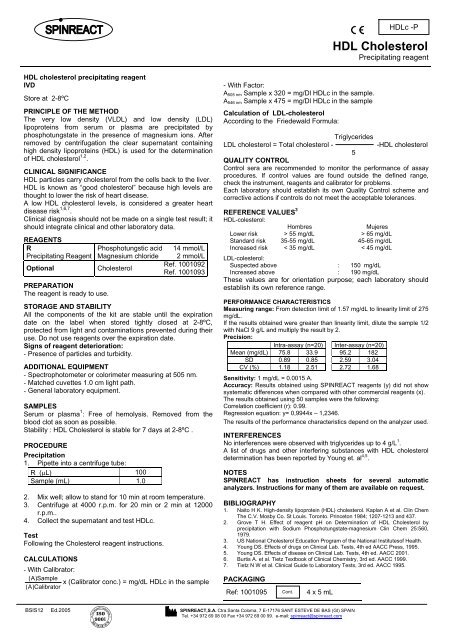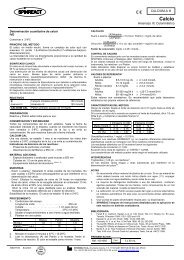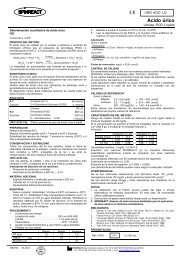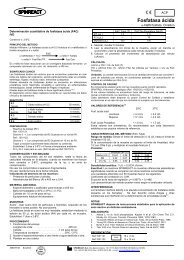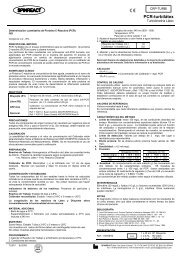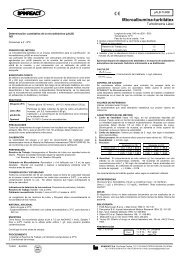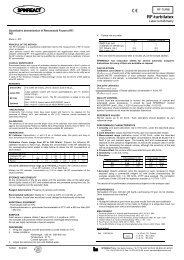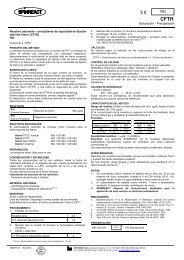Colesterol HDL - IDCCA
Colesterol HDL - IDCCA
Colesterol HDL - IDCCA
You also want an ePaper? Increase the reach of your titles
YUMPU automatically turns print PDFs into web optimized ePapers that Google loves.
<strong>HDL</strong> cholesterol precipitating reagent<br />
IVD<br />
Store at 2-8ºC<br />
PRINCIPLE OF THE METHOD<br />
The very low density (VLDL) and low density (LDL)<br />
lipoproteins from serum or plasma are precipitated by<br />
phosphotungstate in the presence of magnesium ions. After<br />
removed by centrifugation the clear supernatant containing<br />
high density lipoproteins (<strong>HDL</strong>) is used for the determination<br />
of <strong>HDL</strong> cholesterol 1,2 .<br />
CLINICAL SIGNIFICANCE<br />
<strong>HDL</strong> particles carry cholesterol from the cells back to the liver.<br />
<strong>HDL</strong> is known as “good cholesterol” because high levels are<br />
thought to lower the risk of heart disease.<br />
A low <strong>HDL</strong> cholesterol levels, is considered a greater heart<br />
disease risk 1,6,7 .<br />
Clinical diagnosis should not be made on a single test result; it<br />
should integrate clinical and other laboratory data.<br />
REAGENTS<br />
R<br />
Precipitating Reagent<br />
Optional Cholesterol<br />
PREPARATION<br />
The reagent is ready to use.<br />
Phosphotungstic acid 14 mmol/L<br />
Magnesium chloride 2 mmol/L<br />
Ref. 1001092<br />
Ref. 1001093<br />
STORAGE AND STABILITY<br />
All the components of the kit are stable until the expiration<br />
date on the label when stored tightly closed at 2-8ºC,<br />
protected from light and contaminations prevented during their<br />
use. Do not use reagents over the expiration date.<br />
Signs of reagent deterioration:<br />
- Presence of particles and turbidity.<br />
ADDITIONAL EQUIPMENT<br />
- Spectrophotometer or colorimeter measuring at 505 nm.<br />
- Matched cuvettes 1.0 cm light path.<br />
- General laboratory equipment.<br />
SAMPLES<br />
Serum or plasma 1 : Free of hemolysis. Removed from the<br />
blood clot as soon as possible.<br />
Stability : <strong>HDL</strong> Cholesterol is stable for 7 days at 2-8ºC .<br />
PROCEDURE<br />
Precipitation<br />
1. Pipette into a centrifuge tube:<br />
3<br />
R (µL) 100<br />
Sample (mL) 1.0<br />
2. Mix well; allow to stand for 10 min at room temperature.<br />
3. Centrifuge at 4000 r.p.m. for 20 min or 2 min at 12000<br />
r.p.m..<br />
4. Collect the supernatant and test <strong>HDL</strong>c.<br />
Test<br />
Following the Cholesterol reagent instructions.<br />
CALCULATIONS<br />
- With Calibrator:<br />
( A)<br />
Sample<br />
x (Calibrator conc.) = mg/dL <strong>HDL</strong>c in the sample<br />
( A)<br />
Calibrator<br />
- With Factor:<br />
A505 nm Sample x 320 = mg/Dl <strong>HDL</strong>c in the sample.<br />
A546 nm Sample x 475 = mg/Dl <strong>HDL</strong>c in the sample<br />
Calculation of LDL-cholesterol<br />
According to the Friedewald Formula:<br />
BSIS12 Ed.2005 SPINREACT,S.A. Ctra.Santa Coloma, 7 E-17176 SANT ESTEVE DE BAS (GI) SPAIN<br />
Tel. +34 972 69 08 00 Fax +34 972 69 00 99. e-mail: spinreact@spinreact.com<br />
<strong>HDL</strong>c -P<br />
<strong>HDL</strong> Cholesterol<br />
Precipitating reagent<br />
Triglycerides<br />
LDL cholesterol = Total cholesterol - -<strong>HDL</strong> cholesterol<br />
5<br />
QUALITY CONTROL<br />
Control sera are recommended to monitor the performance of assay<br />
procedures. If control values are found outside the defined range,<br />
check the instrument, reagents and calibrator for problems.<br />
Each laboratory should establish its own Quality Control scheme and<br />
corrective actions if controls do not meet the acceptable tolerances.<br />
REFERENCE VALUES 3<br />
<strong>HDL</strong>-colesterol:<br />
Hombres Mujeres<br />
Lower risk > 55 mg/dL > 65 mg/dL<br />
Standard risk 35-55 mg/dL 45-65 mg/dL<br />
Increased risk < 35 mg/dL < 45 mg/dL<br />
LDL-colesterol:<br />
Suspected above : 150 mg/dL<br />
Increased above : 190 mg/dL<br />
These values are for orientation purpose; each laboratory should<br />
establish its own reference range.<br />
PERFORMANCE CHARACTERISTICS<br />
Measuring range: From detection limit of 1.57 mg/dL to linearity limit of 275<br />
mg/dL.<br />
If the results obtained were greater than linearity limit, dilute the sample 1/2<br />
with NaCl 9 g/L and multiply the result by 2.<br />
Precision:<br />
Intra-assay (n=20) Inter-assay (n=20)<br />
Mean (mg/dL) 75.8 33.9 95.2 182<br />
SD 0.89 0.85 2.59 3.04<br />
CV (%) 1.18 2.51 2.72 1.68<br />
Sensitivity: 1 mg/dL = 0.0015 A.<br />
Accuracy: Results obtained using SPINREACT reagents (y) did not show<br />
systematic differences when compared with other commercial reagents (x).<br />
The results obtained using 50 samples were the following:<br />
Correlation coefficient (r): 0.99.<br />
Regression equation: y= 0,9944x – 1,2346.<br />
The results of the performance characteristics depend on the analyzer used.<br />
INTERFERENCES<br />
No interferences were observed with triglycerides up to 4 g/L 1 .<br />
A list of drugs and other interfering substances with <strong>HDL</strong> cholesterol<br />
determination has been reported by Young et. al 4,5 .<br />
NOTES<br />
SPINREACT has instruction sheets for several automatic<br />
analyzers. Instructions for many of them are available on request.<br />
BIBLIOGRAPHY<br />
1. Naito H K. High-density lipoprotein (<strong>HDL</strong>) cholesterol. Kaplan A et al. Clin Chem<br />
The C.V. Mosby Co. St Louis. Toronto. Princeton 1984; 1207-1213 and 437.<br />
2. Grove T H. Effect of reagent pH on Determination of <strong>HDL</strong> Cholesterol by<br />
precipitation with Sodium Phosphotungstate-magnesium Clin Chem 25:560,<br />
1979.<br />
3. US National Cholesterol Education Program of the National Institutesof Health.<br />
4. Young DS. Effects of drugs on Clinical Lab. Tests, 4th ed AACC Press, 1995.<br />
5. Young DS. Effects of disease on Clinical Lab. Tests, 4th ed. AACC 2001.<br />
6. Burtis A. et al. Tietz Textbook of Clinical Chemistry, 3rd ed. AACC 1999.<br />
7. Tietz N W et al. Clinical Guide to Laboratory Tests, 3rd ed. AACC 1995.<br />
PACKAGING<br />
Ref: 1001095 Cont.<br />
4 x 5 mL


